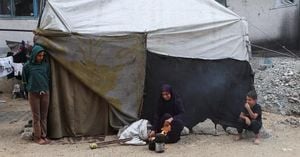As South Korea moves deeper into September, the nation is experiencing a bout of heavy autumn rain, bringing with it fluctuating temperatures, gusty winds, and the kind of weather that keeps umbrellas in high demand. According to forecasts from the Korea Meteorological Administration, the rain began in earnest on the night of September 19, 2025, and is expected to persist in various regions through the weekend, affecting everything from daily commutes to coastal safety.
Jeju Island was among the first to feel the brunt, with rainfall amounts ranging from 10 to 30 millimeters recorded overnight. Yonhap News TV reported that the island, along with coastal regions, was placed under a heavy rain advisory, warning residents to brace for not just rain but also strong winds. The forecast predicted these conditions would last until the morning of September 20, with some eastern coastal regions, such as North Gyeongsang, expecting rain to linger into the night, and parts of eastern Gangwon seeing showers continue until the morning of September 21.
But Jeju was hardly alone in facing wet weather. Across the mainland, the rain picked up steam as the night wore on. According to Kyeonggi Ilbo, most regions were expected to receive between 20 and 30 millimeters of rain per hour during the heaviest periods, with some areas like Chungnam and Jeonbuk anticipating up to 50 millimeters in a single burst. The central and northern regions, including Seoul, Gyeonggi, and Incheon, were forecasted to get between 10 and 60 millimeters, while the southern and eastern parts of Gangwon could see totals climb to 80 millimeters or more. In fact, the southern coastal areas and Jeonbuk’s western region were singled out for particularly intense downpours, with some spots potentially exceeding 100 millimeters.
These aren’t the kind of gentle autumn showers that inspire poetry. Instead, they come with thunder, lightning, and the occasional gust strong enough to rattle windows. The Korea Meteorological Administration, as quoted by Kyeonggi Ilbo, urged, “Please pay attention to safety accidents such as facility collapses due to precipitation and strong winds, and be careful when driving in areas with thick fog.” The warning is not without merit—winds in the western and southern coastal areas are expected to reach speeds of 25 to 55 kilometers per hour (7 to 15 meters per second), while waves in the East and West Seas could rise as high as 3.5 meters, prompting marine safety advisories.
For those living along the east coast, there’s another hazard: high, rolling waves known locally as ‘neulleum’ waves. These can surge unexpectedly, making coastal visits risky and threatening the safety of fishermen and beachgoers alike. The forecast even mentioned that waves near Gangneung could reach up to 200 meters in height, underscoring the need for caution near the shoreline.
Amid all this, temperatures have managed to stay relatively mild—almost a silver lining for those who don’t mind a little rain. The morning of September 20 saw temperatures in Seoul and the surrounding metropolitan area hover around 18 degrees Celsius, with daytime highs expected to reach 24 degrees in Seoul, 27 in Daegu, and up to 29 in Busan. The range across the country was fairly broad, with morning lows as cool as 16 degrees in places like Chuncheon and as warm as 26 degrees on Jeju. Daytime highs generally stayed in the 21 to 29-degree range, making for a pleasantly cool, if wet, autumn day.
Looking ahead, the rain is expected to ease in most places by midday on September 20, but not everywhere will dry out at the same pace. The eastern coastal region of Gangwon, for instance, could see showers persist until noon on September 21, while some parts of North Gyeongsang will have to wait until Saturday night for clear skies. And just when you think you can stash the umbrella, the forecast warns of more rain on the horizon. According to bnt News, the national weather outlook predicts another round of showers on September 23, with cloudy conditions dominating the week of September 22 to 28.
This patchwork of rain and cloud cover is typical for autumn in Korea, a season known for its dramatic temperature swings and fast-changing weather. By Sunday, September 21, the skies are expected to clear somewhat, though clouds will linger, especially in the east. Morning temperatures will dip to between 13 and 20 degrees, while daytime highs should range from 23 to 29 degrees. The trend continues into the following week, with more clouds and the occasional shower, and temperatures holding steady in the low- to mid-20s Celsius overnight and mid- to high-20s during the day.
One small comfort: the air quality is expected to remain good throughout the period, with fine dust levels rated as ‘good’ nationwide. That’s a rare treat for residents accustomed to battling seasonal smog, and it means that when the rain does pause, there’s every reason to step outside and enjoy the fresh, crisp air—provided you don’t forget a jacket.
Still, the rain brings its own challenges. The combination of heavy showers, gusty winds, and fog means that travel—especially by road or sea—requires extra caution. The Korea Meteorological Administration continues to issue advisories for facility safety and traffic, reminding the public not to underestimate the risks posed by sudden weather changes. And for those living near rivers, coasts, or low-lying areas, vigilance remains the watchword as water levels can rise quickly and unexpectedly.
In sum, South Korea’s late September weather is a study in contrasts: warm days and cool nights, bursts of heavy rain followed by lingering clouds, and the ever-present possibility of another storm just around the corner. While the forecast may be unpredictable, one thing is certain—autumn in Korea remains as lively as ever, keeping residents and meteorologists alike on their toes.
![[전국 날씨예보] 20일까지 최대 100mm 이상 비...충남권·전북서부 강한 비](https://thumbor.evrimagaci.org/9Ize0dB8mtZLBpXnZfXHz5Xwv_I=/200x0/tpg%2Fsources%2F8da1dd8c-250f-4c04-b5eb-75efbc716e43.jpeg)
![전국 최대 100mm 비… 강원산지 짙은 안개 유의 [오늘날씨]](https://thumbor.evrimagaci.org/e09yuzt9OOk7dEfMBoADC8erHMw=/200x0/tpg%2Fsources%2Fdb17dcbd-367a-4db9-ab7f-aaec7247fec8.jpeg)
![[제주날씨] 트리플 태풍, 우리나라 영향은? 모둠벌초 내일 오전 강한 비](https://thumbor.evrimagaci.org/rzDLciIMHTvQktTNKYfdkO8yfWc=/200x0/tpg%2Fsources%2F423fd185-7837-44d2-9402-38a234e1d15a.jpeg)
![[날씨] 주말 오전까지 전국 비…충남·전북 시간당 최대 50㎜ : 네이트 날씨](https://thumbor.evrimagaci.org/-VGieF8HunX_RNV7K9OiS8ER8S4=/200x0/tpg%2Fsources%2F3be65fd6-12eb-4323-8ed0-233c766c05c0.jpeg)



